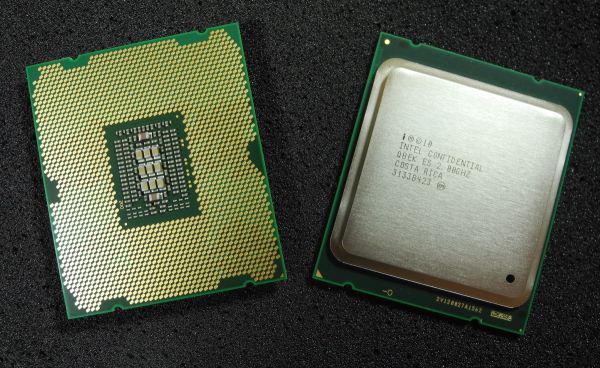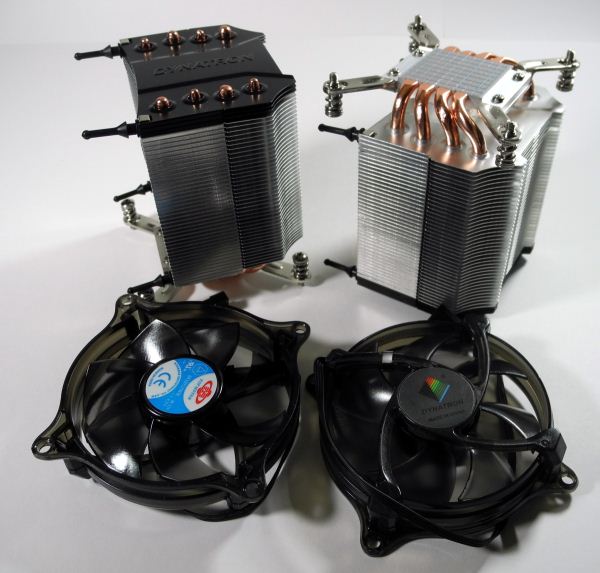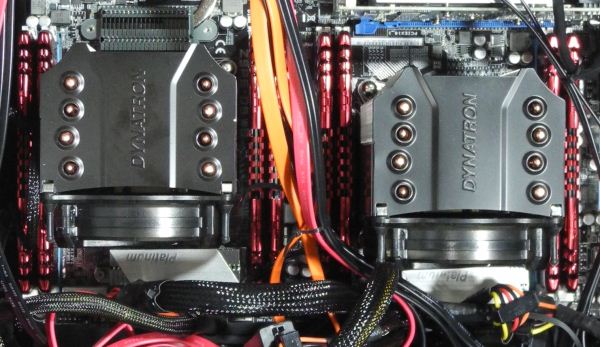Building the 2012 AnandTech SMB / SOHO NAS Testbed
by Ganesh T S on September 5, 2012 6:00 PM EST- Posted in
- IT Computing
- Storage
- NAS
Motherboard
A number of vendors exist in the dual processor workstation motherboard market. At the time of the build, LGA 2011 Xeons had already been introduced, and we decided to focus on boards supporting those processors. Since we wanted to devote one physical disk and one network interfaces to each VM, it was essential that the board have enough PCI-E slots for multiple quad-ported server NICs as well as enough native SATA ports. For our build, we chose the Asus Z9PE-D8 WS motherboard with an SSI EEB form factor..

Based on the C602 chipset, this dual LGA 2011 motherboard supports 8 DIMMs and has 7 PCIe 3.0 slots. The lanes can be organized as (2 x16 + 1 x16 + 1x8 or 4 x8 + 1x16 + 1 x8). All the slots are physically 16 lanes wide. The Intel C602 chipset provides two 6 Gbps SATA ports and eight SATA 3 Gbps ports. A Marvell PCIe 9230 controller provides four extra 6 Gbps ports making for a total of 14 SATA ports. This allows us to devote two ports to the host OS of the workstation and one port to each of the twelve planned VMs. The Z9PE-D8 WS motherboard also has two GbE ports based on the Intel 82574L. Two Gigabit LAN controllers are not going to be sufficient for all our VMs. We will address this issue further down in the build.
The motherboard also has 4 USB 3.0 ports, thanks to an ASMedia USB 3.0 controller. The Marvell SATA - PCIe bridge and the ASMedia USB3 controller are connected to the 8 PCIe lanes in the C602. All the PCIe 3.0 lanes come from the processors. Asus also provides support for SSD caching (where any installed SSD can be used as a cache for frequently accessed data, without any size limitations) in the motherboard. The Z9PE-D8 WS also has a Realtek ALC898 HD audio codec, but neither of the above aspects are of relevance to our build.
CPUs
One of the main goals of the build was to ensure low power consumption. At the same time, we wanted to run twelve VMs simultaneously. In order to ensure smooth operation, each VM needs at least one vCPU allocated exclusively to it. The Xeon E5-2600 family (Sandy Bridge-EP) has CPUs with core counts ranging from 2 to 8, with TDPs from 60 W to 150 W. Each core has two threads. Keeping in mind the number of VMs we wanted to run, we specifically looked at the 6 and 8 core variants, as two of those processors would give us 12 and 16 cores. Within these, we restricted ourselves to the low power variants. These included the hexa-core E5-2630L (60 W TDP) and the octa-core E5-2648L / E5-2650L (70 W TDP).
CPU decisions for machines meant to run VMs have to be usually made after taking the requirements of the workload into consideration. In our case, the workload for each VM involved IOMeter and Intel NASPT (more on these in the software infrastructure section). Both of these softwares tend to be I/O-bound, rather than CPU-bound, and can run reliably on even Pentium 4 processors. Therefore, the per-core performance of the three processors was not a factor that we were worried about.
Out of the three processors, we decided to go ahead with the hexa-core Xeon E5-2630L. The cores run at 2 GHz, but can Turbo up to 2.5 GHz when just one core is active. Each core has a 256 KB L2 cache, with a common 15 MB L3. With a TDP of just 60W, it enabled us to focus on energy efficiency. Two Xeon E5-2630Ls (a total of 120W TDP) enabled us to proceed with our plan to run 12 VMs concurrently.
Coolers
The choice of coolers for the processors is dictated by the chassis used for the build. At the start of the build, we decided to go with a tower desktop configuration. Asus recommended the Dynatron R17 for use with the Z9PE-D8 WS, and we went ahead with their suggestion.
The R17 coolers are meant for the LGA 2011 sockets for 3U and above rackmount form factors as well as tower desktop and workstation solutions. They are made of aluminium fins with four copper heat pipes. A thermal compound is pre-printed at the base. Installation of the R17s was quite straightforward, but care had to be taken to ensure that the side meant to mount the cooler’s fans didn’t face the DIMM slots on the Z9PE-D8 WS.
The fans on the R17 operate between 1000 and 2500 rpm, and consume between 0.96W and 3W at these speeds. Noise levels are respectable and range from 17 dbA to 32 dbA. The R17 has the ability to cool CPUs with up to 160W TDP. The 60W E5-2630Ls were effectively maintained between 45C and 55C even under our full workloads by the Dynatron R17s.
















74 Comments
View All Comments
ganeshts - Thursday, September 6, 2012 - link
Thanks for unearthing that one.. Fixed now.ypsylon - Thursday, September 6, 2012 - link
14 SSDs. I know it is only to simulate separate clients, but to be honest this whole test is ultimately meaningless. No reasonable business (not talking about 'man with a laptop' kind of company) will entrust crucial data to SSD(s) (in particular non-industry class standard SSDs). Those disks are far too unreliable and HDDs trounce them in that category every time. Whether you like it or not, HDDs are still here and I'm absolutely certain that they will outlive SSDs by a fair margin. Running a business myself and thank you very much HDDs are the only choice, RAID 10, 6 or 60 depending on a job. Bloody SDDs, hate those to the core (tested). Good for laptops or for geeks who benching system 24/7 not for serious job.ypsylon - Thursday, September 6, 2012 - link
Dang 12 not 14 , ha, ha.mtoma - Thursday, September 6, 2012 - link
If you love so much the reliability of HDDs, I must ask you: what SSD brand have failed you? Intel? Samsung? You know, they are statistics that show Intel and Samsung SSD are much more reliable 24/7 than many Enterprise HDDs. I mean, on paper, the enterprise HDDs looks great, but in reality they fail more than they should (in a large RAID array vibration is a maine concern). After all, the same basic technology applies to regular HDDs. On top of that, some (if not all) server manufacturers put refurbished HDDs in new servers (I have seen IBM doing that and I was terrified). Perhaps this is not a widespread practice, but it is truly terrifying.So, pardon me if I say: to hell with regular HDDs. Buy enterprise grade SSDs, you get the same 5 year warranty.
extide - Thursday, September 6, 2012 - link
Dude you missed the point ENTIRELY, the machine they built is to TEST NAS's. They DID NOT BUILD A NAS.Wardrop - Saturday, September 8, 2012 - link
I can't work out whether this guy is trolling or not? A very provocative post without really any detail.AmdInside - Thursday, September 6, 2012 - link
Isn't Win7 x64 Ultimate a little too much for a VM? Would be nice to see videos.ganeshts - Thursday, September 6, 2012 - link
We wanted an OS which would support both IOMeter and Intel NASPT. Yes, we could have gone with Windows XP, but the Win 7 installer USB drives were on the top of the heap :)AmdInside - Thursday, September 6, 2012 - link
Thankszzing123 - Thursday, September 6, 2012 - link
Hi Ganesh - Thanks for taking my post a few articles back to heart regarding the NAS performance when fully loaded, as it begins to provide some really meaningful results.I have to agree with some of the other posters' comments about the workload though. Playing a movie on one, copying on another, running a VM from a third and working of docs through an SMB share on a fourth would probably be a more meaninful workload in a prosumer's home.
In light of this, might it be an idea to add a new benchmark to AnandTech's Storage Bench that measures all these factors?
In terms of your setup, there's a balance to be struck. I really like the concept you're doing of using 12 VM's to replicate a realistic environment in the way you can do. However when an office has 12 clients, they're probably using a proper file server or multiple NAS's. 3-4 clients is probably the most typical set up in a SOHO/home setup.
10GbE testing is missing, and a lot of NAS's are beginning to ship with 10GbE. With switches like the Cisco SG500X-24 also supporting 10GbE and becoming slowly more affordable, 10GbE is slowly but surely becoming more relevant. 1 SSD and 1 GbE connection isn't going to saturate it - 10 will, and is certainly meaninful in a multi-user context, but this is AnandTech. What about absolute performance?
How about adding a 13th VM that leashes together all the 12 SSD's and aggregates all the 12 I340 links to provide a beast of RAIDed SSD's and 12GbE connectivity (the 2 extra connections should smoke out net adapters that aren't performing to spec as well).